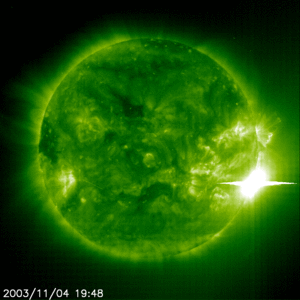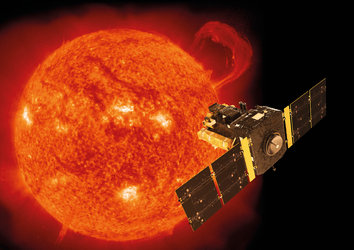The Sun has a great idea
A light bulb-shaped eruption leaps from the Sun and blasts into space in this archival image from the ESA/NASA Solar and Heliospheric Observatory, SOHO.
SOHO captured the scene on 27 February 2000, watching as a large filament rose from the Sun’s broiling atmosphere and evolved into the coronal mass ejection loop seen here.
A coronal mass ejection – or CME – is a huge cloud of magnetised plasma ejected from the Sun’s atmosphere – the corona – and launched into interplanetary space. They comprise millions of tonnes of gas and race away from the Sun at hundreds of kilometres per second.
If a powerful CME is aimed in Earth’s direction then the resulting geomagnetic storm may trigger regional power outages and communications blackouts.
But CMEs also have an appealing side: interactions with Earth’s magnetic field ignite auroras over the northern or southern poles, producing spectacular natural light displays that dance across the night sky in shades of red and green.
This particular CME shows three distinctive features as it leaps from the Sun. A bright loop of plasma leads the way with a dark, low-density cavity behind it. The light bulb ‘filament’ – a bright orb of solar plasma – follows behind and dominates the centre of feature.















 Germany
Germany
 Austria
Austria
 Belgium
Belgium
 Denmark
Denmark
 Spain
Spain
 Estonia
Estonia
 Finland
Finland
 France
France
 Greece
Greece
 Hungary
Hungary
 Ireland
Ireland
 Italy
Italy
 Luxembourg
Luxembourg
 Norway
Norway
 The Netherlands
The Netherlands
 Poland
Poland
 Portugal
Portugal
 Czechia
Czechia
 Romania
Romania
 United Kingdom
United Kingdom
 Slovenia
Slovenia
 Sweden
Sweden
 Switzerland
Switzerland































